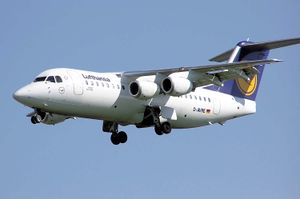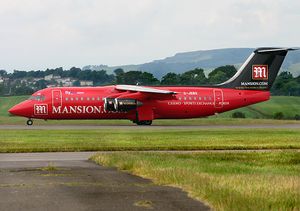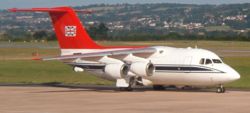PlaneSpottingWorld welcomes all new members! Please gives your ideas at the Terminal.
BAe 146
| British Aerospace BAe 146/Avro RJ | |
|---|---|
| Buzz BAe 146-300 | |
| Type | Airliner |
| Manufacturers | British Aerospace BAE Systems |
| Maiden flight | 1981-09-03 |
| Introduced | May 1983 |
| Status | Active service |
| Produced | 1978-2003 |
The BAe 146 is a medium-sized commercial aircraft which was manufactured in the United Kingdom by British Aerospace (which later became part of BAE Systems). Production ran from 1983 until 2002, switching to an improved version known as the Avro RJ in 1992. A further-improved version, the Avro RJX – with new engines – was announced in 1997, but only three prototypes were built before production ceased in late 2001.
The BAe 146/Avro RJ carries its four turbofan jet engines on a high wing above the fuselage (not below, or at mid-fuselage, as on most conventional civilian aircraft) and has a T-tail. The aircraft has STOL capabilities and very quiet operation; it has been marketed under the name Whisperjet. It sees wide usage at small city-based airports. In its primary role it serves as a regional jet, short-haul airliner or feederliner. The BAe 146/Avro RJ is in wide use among European airlines, such as Lufthansa and SN Brussels Airlines. The freight-carrying version has the designation "QT" (Quiet Trader), while a convertible version is designated "QC".
The BAe 146 comes in -100, -200 and -300 models. The equivalent Avro RJ versions are designated RJ70, RJ85, and RJ100.
Contents
History
Hawker Siddeley carried out the original design in 1973 using the designation HS.146, but soon abandoned the project as a result of the world economic downturn resulting from the 1973 oil crisis. Low-key development proceeded, however, and in 1978 British Aerospace, Hawker Siddeley's corporate successor, re-launched the project. The name 146 comes from the original De Havilland design number, DH146, which was continued by Hawker Siddeley. The type name "Avro RJ" superseded "BAe 146" in 1993.


The BAe 146 received its Certificate of Airworthiness on 1983-02-08.[1]
Higher thrust LF507 turbofan engines from Honeywell, housed in newly designed nacelles, replaced the original ALF-502 Lycoming engines. Production of this aircraft has ended, with the final four aircraft being delivered in October-November 2003. Many airlines are predicted to replace the Avro/BAe with the Airbus A318, Bombardier CRJ 700, or Embraer models such as the Embraer 170 and Embraer 190.
The early aircraft were built at what was the original De Havilland factory at Hatfield, Hertfordshire. The Avro RJ family of aircraft was built at the BAE Systems Regional Aircraft Centre at the Avro Airfield at Woodford in England. 166 Avro RJ aircraft were delivered between 1993 and 2002.
The aircraft have proven to be useful on "high" density regional and short-haul routes. One of the main features of the BAe 146 that made it different from other regional aeroplanes is the fact that it features six-abreast seating which proves to be more comfortable than the more traditional four- or five-abreast seating of planes in its class. The plane is also renowned for its relatively low noise generation, a positive feature which won the hearts of many operators who wanted to fly in and out of noise stringent airports within cities.
Problems
The ALF 502 turbofans were derived from Lycoming's helicopter turboshaft designs and suffered from some reliability problems. The internal electronics were prone to overheating which could trigger an automatic shutdown of an engine with no option of in-flight restarting, and certain rare atmospheric conditions caused loss of engine thrust due to internal icing.[2]. As the result, BAe 146 mechanics quipped that "BAe" stood for "Bring Another Engine." In recent years, there have been cases where toxic fumes from engine oil have entered the air-conditioning system and entered the cockpit, adversely affecting the pilots. [3].
Models
BAe 146-100 and Avro RJ70
First flight of the -100 occurred on 3 September 1981,[4] with deliveries commencing in 1983. The launch customer in March 1983 was Dan-Air soon followed by the RAF's Royal Flight. The -100 migrated last to the Avro RJ standard development, with first deliveries of the RJ70 beginning in late 1993. The RJ70 differed from the 146-100 in having FADEC LF 507 engines and digital avionics. The RJ70 seats 70 passengers, 82 six abreast or 94 in high-density configuration.

BAe 146-200 and Avro RJ85
The 146-200 features a 2.41 m (7 ft 11 in) fuselage extension and reduced seat-distance costs. The -200 first flew in August 1982 and entered service six months later. The RJ85, the first RJ development of the BAe 146 family, features an improved cabin and the more efficient LF 507 s. Deliveries of the RJ85 began in April 1993. The RJ85 seats up to 112 passengers.
BAe 146-300 and Avro RJ100
Designers' initial proposals for the -300, the final development of the 146 product line, included a 3.2 m extension to the fuselage of the -200, more powerful engines and winglets. However due to the requirements of airlines for higher efficiency rather than capacity the production 146-300 emerged as a 2.44 m stretch of the -200, without winglets or the proposed ALF 502R-7. Deliveries began in December 1988. The Avro version of the 146-300, the second such development of the 146 product line, became the RJ100. It shared the fuselage of the 146 version, but with interior, engine and avionics improvements. The most common configuration in the RJ100 seats 100 passengers. The RJ115 seats 116 as standard or up to a maximum of 128 in a high-density layout.
Specific variants
- Statesman
VIP or corporate transport version. - 146-QT (Quiet Trader)
Freighter version. - 146-QC
Convertible passenger/freight version. - 146-STA
Military transport version.
Avro RJX Series
The RJX-70, RJX-85 and RJX-100 aircraft represented advanced variants of the Avro RJ Series. The RJX used Honeywell AS977 turbofans for greater efficiency (15% less fuel-burn, 17% increased range), quieter performance and 20% less maintenance costs. Druk Air of Bhutan placed orders for two RJX-85s, while British European placed orders for 12 RJX-100s. However, BAE Systems terminated the project in December 2001, having completed and flown only three aircraft - a prototype each of the RJX-85 and RJX-100, and a production RJX-100 for British European. BAE reached an agreement with Druk Air and British European in early 2002 in which the airlines agreed not to enforce their firm orders for the RJX. BAE explored the possibility of manufacturing 14 "hybrid" aircraft, however British European at least was unwilling to accept the risk of operating a unique type.[5]
The termination of the RJX project marked the end of commercial airliner-production in the United Kingdom.
Civilian operators
- In August 2006 a total of 158 BAE 146 aircraft (all variants) remain in airline service. Major operators include: China Eastern Airlines (10), National Jet Systems (14), CityJet (19), Eurowings (14), Flybe (14) and TNT Airways (13). Some 20 other airlines also operate smaller numbers of the type.[6]
- In August 2006 a total of 152 Avro RJ aircraft (all variants) also remain in airline service. Major operators include: BA Connect (10), Lufthansa CityLine (18), SN Brussels Airlines (26), and Swiss International Air Lines (24). Some 12 other airlines also operate smaller numbers of the type.[6]
Military operators
Incidents
The BAe-146/Avro RJ has been involved in seven hull-loss accidents with a total of 216 fatalities.[7] [8]
- On 7 December 1987 a Pacific Southwest Airlines Flight 1771 BAe 146-200 (registration: N350PS) crashed after a disgruntled former USAir employee aims a .44 Magnum pistol and fires several shots in or near the cockpit area, causing the aircraft to enter a steep nosedive. All of the 43 passengers and crew members onboard were killed. At the time airline employees were allowed to bypass security checkpoints. [9]
- On 20 February 1991 a LAN Chile BAe 146-200A (registration: CC-CET) overran runway 8 while landing at Puerto Williams Airport (WPU), Chile, killing 20 of the 73 people onboard. [10]
- On 23 July 1993 a China Northwest Airlines BAe 146-300 (registration: B-2716) crashed while attempting to take off from Yinchuan Airport (INC), People's Republic of China. 55 of the 113 passengers and crew were killed. [11]
- On 25 September 25 1998 a Paukn Air BAe 146-100 (registration: EC-GEO) crashed while on an approach to runway 15 at Melilla Airport (MLN/GEML), Spain. All of the 38 passengers and crew were killed. [12]
- On 24 November 2001 a Crossair flight 3597 Avro RJ-100 (registration: HB-IXM) crashed while on a VOR/DME approach to runway 28 at Zürich-Kloten Airport (ZRH/LSZH), Switzerland. 24 of the 33 passengers and crew were killed. [13]
- On 8 January 2003 a Türk Hava Yollari Avro RJ-100 (registration: TC-THG) crashed while on a VOR/DME approach to runway 34 at Diyarbakir Airport (DIY/LTCC), Turkey. All of the 80 passengers and crew were killed. [14]
- On 10 October 2006 a Atlantic Airways Flight 670 BAe 146-200A (registration OY-CRG) skidded off the runway while landing at Stord Airport, Norway. The Spoilers did not deploy when the aircraft landed. 3 passengers and 1 crew member were killed, of the 16 persons onboard.[15] [16]
Specifications (BAe 146-200)
General characteristics
- Crew: 4 with 2 flight attendants
- Capacity: 85-100 passengers
- Length: 93 ft 8 in (28.55 m)
- Wingspan: 86 ft 5 in (26.34 m)
- Height: 28 ft 3 in (8.61 m)
- Wing area: 832 ft² (77.30 m²)
- Empty weight: 73,415 lb (33,300 kg)
- Max takeoff weight: 93,035 lb (42,200 kg)
- Powerplant: 4× Honeywell ALF 502R-5 turbofans, 6,970 lbf (31 kN) each
Performance
- Maximum speed: 555 mph (482 knots, 893 km/h)
- Cruise speed: 465 mph (404 knots, 750 km/h)
- Range: 1,290 mi (2,075 km) with 25,000 lb (11,000 kg) of payload
- Service ceiling: 31,200 ft (9,500 m)
Having extremely large flaps and spoilers, and a large split air brake mounted in the tail, the plane does not need reverse thrust at landing. Consequently, the four engines (supplied by the U.S. manufacturer Lycoming) do not have this facility.
References
- ↑ Donne, Michael. "BAe 146 cleared for delivery to airlines", Financial Times, The Financial Times Limited, 1983-02-09, p. 21. Retrieved on 2007-01-06.
- ↑ Airline Industry Information. UPDATE: Braathens have BAe 146 aircraft.. Retrieved on 2006-04-30.
- ↑ The Guardian. Toxic cockpit fumes that bring danger to the skies. Retrieved on 2006-04-30.
- ↑ The British Aircraft Directory. Historical flight details for the BAe 146 aircraft series. Retrieved on 2006-09-01.
- ↑ Vines, Mike. "RJX Dead and Buried", Business & Commercial Aviation, The McGraw-Hill Companies, Inc., March 2002, p. 32. Retrieved on 2007-01-05.
- ↑ 6.0 6.1 Flight International, 3-9 October 2006
- ↑ Aviation Safety Network - BAe 146
- ↑ Have taken 216 human lifes Bergens Tidende, October 11, 2006 (Norwegian)
- ↑ Aviation Safety Network report - December 7, 1987 crash
- ↑ Aviation Safety Network report - February 20, 1991 crash
- ↑ Aviation Safety Network report - July 23, 1993 crash
- ↑ Aviation Safety Network report - September 25, 1998
- ↑ Aviation Safety Network report - November 24, 2001 crash
- ↑ Aviation Safety Network report - January 8, 2003 crash
- ↑ Norway runway blaze kills three, BBC News, October 10, 2006.
- ↑ Aviation Safety Network report - October 10, 2006 crash
External links
- Avro RJ-Technical Data (PDF)
- Smiliner 146 family information page
- Air Berlin British Aerospace BAe 146-200 Departing on MGL Mönchengladbach
- Aerospace-Technology.com
- Aerospace Technology RJX Project Page
- Air Accidents Investigation Branch - Avro 146-RJ100, G-CFAA
- SwissWorldCargo Avro RJ100 «Jumbolino»
- (German) "Jumbolino-Flug abgebrochen"
- THE BAE 146 at Greg Goebel's AIR VECTORS
- Aerosite - BAe 146
- Airliners_net British Aerospace BAe-146
Related content
Designation sequence
Related lists
Lists relating to aviation | |
|---|---|
| General | Timeline of aviation · Aircraft · Aircraft manufacturers · Aircraft engines · Aircraft engine manufacturers · Airports · Airlines |
| Military | Air forces · Aircraft weapons · Missiles · Unmanned aerial vehicles (UAVs) · Experimental aircraft |
| Notable incidents and accidents | Military aviation · Airliners · General aviation · Famous aviation-related deaths |
| Records | Flight airspeed record · Flight distance record · Flight altitude record · Flight endurance record · Most produced aircraft |
de:BAe 146 fr:BAe 146 it:BAe 146 ja:BAe 146 sr:BAe 146 fi:BAe 146 sv:British Aerospace BAe 146 zh:BAe 146


